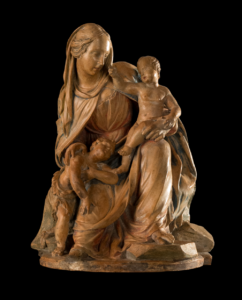Object of the Month: December
Madonna and Child with St. John the Baptist
Polychrome terracotta
Italian, 17th century
The vast collection at the Museum & Gallery contains many hidden treasures that are sometimes overlooked. In my years working for the museum, I don’t remember coming across this piece. Or if I had, I did not give it too much thought as it was one of many pictorial examples of a common theme—the Madonna and Child with the infant St. John the Baptist. While this sculpture may not be one of the biggest or most recognizable, it is a reminder of humility.
The terracotta sculpture was made towards the beginning of the Italian Baroque. The dramatic movement, and attention to anatomical detail is very typical of Baroque art. Mary is portrayed as a graceful, ideal beauty; and the two infants, Jesus and St. John the Baptist, look like active children. Their leaning bodies and outstretched arms lead the viewer through the piece. In fact, this similar pose can be found in another work in the museum’s collection from the Italian Renaissance, Granacci’s Rest on the Flight into Egypt.
It also relates back to another famous visual interpretation of these three individuals—Leonardo da Vinci’s Virgin of the Rocks. There are obvious similarities, such as Mary’s arm wrapped around an adoring St. John the Baptist and Jesus blessing his infant cousin. What may not be as noticeable at first glance is the setting. Of course, one is a painting, and one is a sculpture, but they both feature figures sitting on rocks. This iconography is referred to as the Madonna of Humility. In earlier art history and even during the Renaissance, Mary is sometimes shown as the Queen of Heaven, enthroned in gold beside Jesus. However, in contrast, da Vinci and this Italian sculptor position Mary seated on the ground, which is a possible reference to her resting during their flight to Egypt. By sitting on the ground or on rocks, Mary demonstrates her humility before her Savior.
The Bible records an example of Mary’s meekness before the Lord in Luke 1:46-55. It was after she had received the news that she would give birth to Jesus Christ, the Son of God. Called her Magnificat, she begins by saying, “My soul magnifies the Lord, and my spirit rejoices in God my Savior, for God has looked with favor on the humble estate of His servant. For behold, from now on all generations will call me blessed; for He who is mighty has done great things for me, and holy is His name…”
While not large or ostentatious, this 19-inch terracotta sculpture is as humble as its subject matter. During the holiday season, we celebrate Christ’s birth that was only made possible through the humility of a young woman and the ultimate humbling for the Savior of the world to become flesh and dwell among us.
KC Christmas Beach, M&G summer educator
Published 2023
